
The River Wensum is a chalk river in Norfolk, England and a tributary of the River Yare, despite being the larger of the two rivers. The river is a biological Site of Special Scientific Interest and Special Area of Conservation.
Watts is plural for the unit of power.

Dereham, also known as East Dereham, is a town and civil parish in the Breckland District of the English county of Norfolk. It is situated on the A47 road, about 15 miles (25 km) west of the city of Norwich and 25 miles (40 km) east of King's Lynn.

The Mid-Norfolk Railway (MNR) is a 17+1⁄2 miles (28.2 km) preserved standard gauge heritage railway, one of the longest in Great Britain. Preservation efforts began in 1974, but the line re-opened to passengers only in the mid-1990s as part of the "new generation" of heritage railways. The MNR owns and operates most of the former Wymondham-Fakenham branch line of the Norfolk Railway. The branch opened in 1847, was closed to passengers in stages from 1964 to 1969 as part of the Beeching cuts, and was finally fully closed to goods traffic in 1989.

Norwich Cathedral is an Anglican cathedral in Norwich, Norfolk, dedicated to the Holy and Undivided Trinity. It is the cathedral church for the Church of England Diocese of Norwich and is one of the Norwich 12 heritage sites.
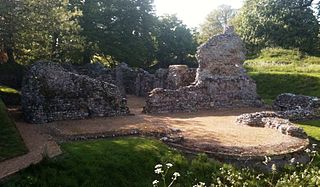
North Elmham is a village and civil parish in the English county of Norfolk. It covers an area of 7.41 sq mi (19.2 km2) and had a population of 1,428 in 624 households at the 2001 census, including Gateley and increasing slightly to 1,433 at the 2011 Census. For the purposes of local government, it falls within the Elmham and Mattishall division of Norfolk County Council and the Upper Wensum ward of Breckland District Council. The village is located along the B1145 a route which runs between King's Lynn and Mundesley.

A drill hall is a place such as a building or a hangar where soldiers practise and perform military drills.
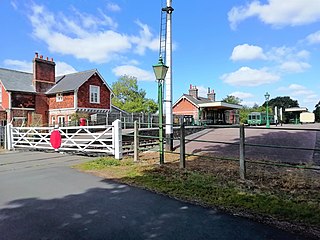
County School railway station is on the Mid-Norfolk Railway in Norfolk, England, and will serve the villages of North Elmham and Guist once services resume. It is 17 miles 40 chains (28 km) down the line from Wymondham and is the northernmost station owned by the Mid-Norfolk Railway Preservation Trust.

Bawdeswell is a small rural village and civil parish in Norfolk, England. At the time of the 2011 census it had a population of 828 and an area of 487 hectares. The village is situated almost in the centre of Norfolk about 14 miles (23 km) northwest of Norwich. For the purposes of local government it falls within the Upper Wensum Ward of Breckland District Council and the Elmham and Mattishall Division of Norfolk County Council. It is on a Roman road that ran east–west between Durobrivae near modern Peterborough and Smallburgh, crossing the Fen Causeway.
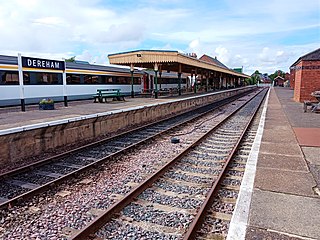
Dereham railway station is a railway station in the town of Dereham in the English county of Norfolk. The station is served by heritage services on the Mid-Norfolk Railway from Dereham to Wymondham.

North Elmham railway station is a railway station in the village of North Elmham in the English county of Norfolk. The station was part of the Wymondham to Wells Branch, and is part of a section of the line being restored by the Mid-Norfolk Railway from Dereham to County School railway station.

Prebendary Joseph Lloyd Brereton,, was a British clergyman, educational reformer and writer, who founded inexpensive schools for the education of the middle classes. Through his work and writings he influenced others to make similar foundations.
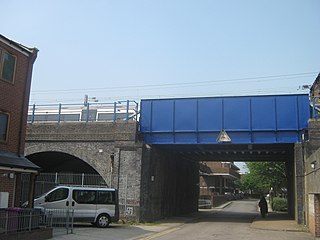
Stepney Causeway is a street in Stepney, in the East End of London. It runs north–south between the A13 road and the B126 Cable Street. It is crossed by a railway bridge carrying the Docklands Light Railway and c2c line out of Fenchurch Street railway station. The street is particularly associated with Thomas John Barnardo, who opened his first shelter for homeless children at No 18.

The Fakenham and Dereham Railway Society (F&DRS) was a heritage railway society in the English county of Norfolk. For a short period of time it operated County School railway station as the Wensum Valley Railway. The F&DRS later became the Mid-Norfolk Railway Preservation Trust, owners and operators of the Mid-Norfolk Railway.
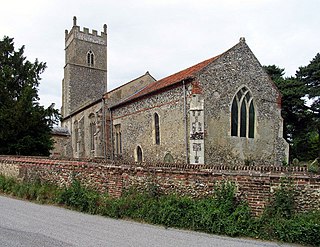
Foxley is a village and civil parish in the English county of Norfolk. The village is about 15 miles (24 km) north-west of Norwich and 9 miles (14 km) south-east of Fakenham. It covers an area of 6.66 km2 (2.57 sq mi) and had a population of 279 in 113 households at the 2001 census, increasing slightly to a population of 285 in 125 households at the 2011 Census. For the purposes of local government, it falls within the Upper Wensum Ward of Breckland District Council and the Elmham and Mattishall Division of Norfolk County Council.

United States Naval Training Center Bainbridge was the U.S. Navy Training Center at Port Deposit, Maryland, on the bluffs of the northeast bank of the Susquehanna River. It was active from 1942 to 1976 under the Commander of the Fifth Naval District, based in Norfolk, Virginia.

North Tuddenham is a civil parish in the English county of Norfolk, North Tuddenham is 3 miles (4.8 km) east of East Dereham, and is close to the A47 road.
Rear-Admiral Sir Harry Hampson Stileman, KBE was a British Royal Navy officer who also served as Director of Dr Barnardo's Homes from 1920 to 1923.
The Wymondham to Wells Branch was a railway built in stages by the Norfolk Railway, Eastern Counties Railway and Wells and Fakenham Company between 1847 and 1857. The railway ran from Wymondham in the south, through Dereham and Fakenham to the coastal town of Wells-next-the-Sea; more specifically, the line ran from Wymondham South Junction, where it met the present-day Breckland Line. Passenger services along the line lasted until 1969; the railway continued to be used for freight until 1989. The southern section of the railway now forms the Mid-Norfolk Railway, with part of the northern section serving as the narrow gauge Wells and Walsingham Light Railway.

The Monastery of The Holy Spirit, known locally as Kirk Edge Convent is a Carmelite monastery for nuns. It is situated on Kirk Edge Road between the villages of Worrall and High Bradfield within the boundaries of the City of Sheffield, England. It is one of 18 carmels in the United Kingdom. The building stands just within the Peak District at a height of 340 metres and has extensive views of the surrounding area.


















